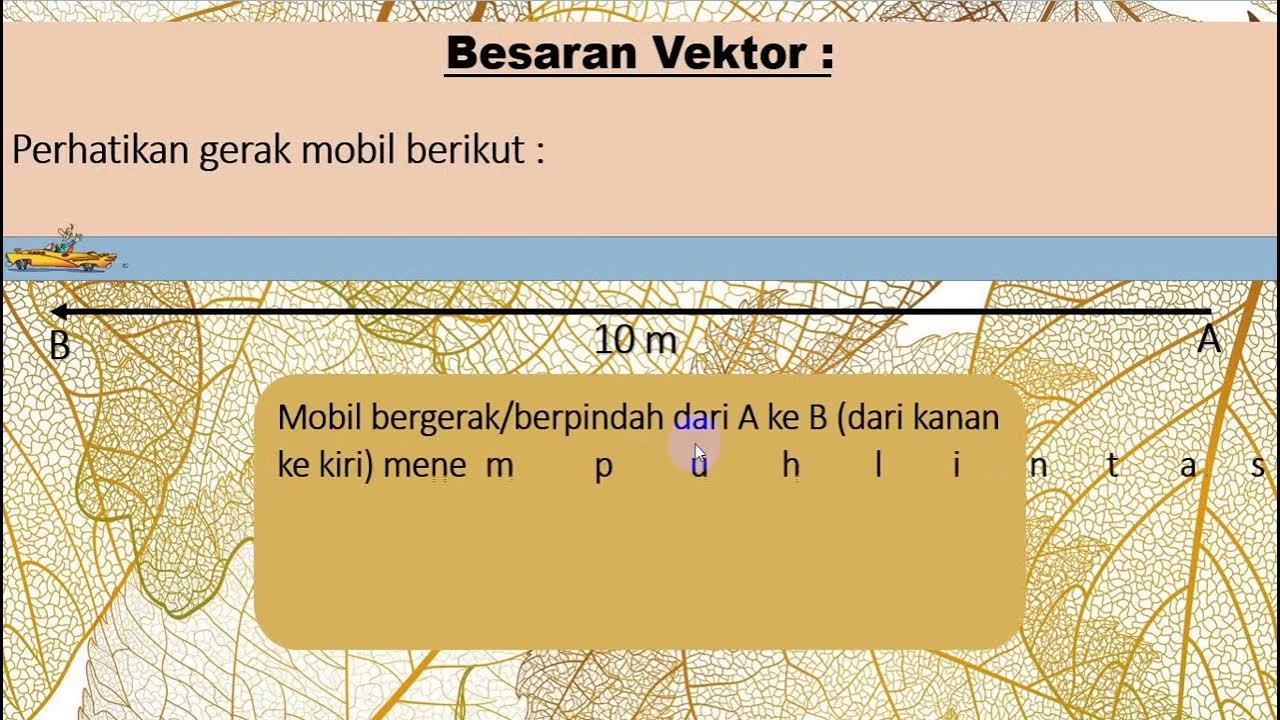Vectors - Precalculus
Summary
TLDRThis video explains the distinction between scalar and vector quantities, emphasizing that scalars have magnitude only while vectors have both magnitude and direction. It provides examples such as mass as a scalar and force as a vector. The video also demonstrates how to express vectors in component form and calculate their magnitudes using the Pythagorean theorem. Additionally, it illustrates how to find terminal points given an initial point and a vector, and explores vectors in three dimensions, culminating in a discussion on the magnitude and direction of vectors in relation to the positive x-axis.
Takeaways
- 😀 A scalar quantity has only magnitude, while a vector quantity has both magnitude and direction.
- 📏 Examples of scalar quantities include mass and temperature, whereas vector quantities include force and velocity.
- ➡️ To express a vector in terms of its components, calculate the difference in the x and y values between two points.
- 📈 The magnitude of a vector can be found using the Pythagorean theorem: √(vx² + vy²).
- 🔄 When determining the components of a vector, use 'i' for the x component and 'j' for the y component.
- 🗺️ Graphing can help visualize vectors and their magnitudes effectively.
- ✏️ The formula for finding the terminal point of a vector from an initial point involves adding the vector components to the initial coordinates.
- 🔍 You can also find the initial point given the terminal point and the vector components using subtraction.
- 🌐 When dealing with three-dimensional vectors, include 'k' for the z component in your calculations.
- 📐 The angle of a vector relative to the positive x-axis can be found using the tangent function: θ = arctan(vy/vx).
Q & A
What is the main difference between scalar and vector quantities?
-A scalar quantity has only magnitude, while a vector quantity has both magnitude and direction. For example, mass is a scalar quantity, whereas force is a vector quantity.
Can you provide an example of how to express a vector in terms of its components?
-To express a vector from point A (1, 2) to point B (4, 6) in terms of its components, you subtract the coordinates: vector V = (4 - 1)i + (6 - 2)j = 3i + 4j.
How do you calculate the magnitude of a vector?
-The magnitude of a vector V can be calculated using the formula |V| = √(Vx² + Vy²), which is derived from the Pythagorean theorem.
What is the magnitude of the vector from point A (-4, -5) to point B (1, 7)?
-The components are 5i + 12j. The magnitude is calculated as |V| = √(5² + 12²) = √(25 + 144) = √169 = 13.
How do you find the terminal point B if you have the initial point A and a vector V?
-You can find point B by adding the components of vector V to the coordinates of point A. For example, if A is (-1, -3) and V is 3i - 2j, point B would be (-1 + 3, -3 - 2) = (2, -5).
What steps would you follow to find the initial point A given the vector V and the terminal point B?
-You would use the formula V = (x2 - x1)i + (y2 - y1)j, rearranging it to find x1 and y1: x1 = x2 - Vx and y1 = y2 - Vy.
What is the expression for a vector in three dimensions?
-In three dimensions, a vector can be expressed in component form as V = Vxi + Vyj + Vzk, where Vx, Vy, and Vz are the differences in the x, y, and z coordinates, respectively.
How can you find the angle of a vector relative to the positive x-axis?
-To find the angle θ of a vector relative to the positive x-axis, you can use the formula θ = arctan(Vy/Vx), where Vy and Vx are the y and x components of the vector.
What is the magnitude of the vector 4i + 6j?
-The magnitude is calculated as |V| = √(4² + 6²) = √(16 + 36) = √52, which can be simplified to 2√13.
What does the notation |V| represent in vector mathematics?
-|V| represents the magnitude of vector V, indicating its length without regard to direction.
Outlines

Cette section est réservée aux utilisateurs payants. Améliorez votre compte pour accéder à cette section.
Améliorer maintenantMindmap

Cette section est réservée aux utilisateurs payants. Améliorez votre compte pour accéder à cette section.
Améliorer maintenantKeywords

Cette section est réservée aux utilisateurs payants. Améliorez votre compte pour accéder à cette section.
Améliorer maintenantHighlights

Cette section est réservée aux utilisateurs payants. Améliorez votre compte pour accéder à cette section.
Améliorer maintenantTranscripts

Cette section est réservée aux utilisateurs payants. Améliorez votre compte pour accéder à cette section.
Améliorer maintenantVoir Plus de Vidéos Connexes

GCSE Physics - Scalar and Vector Quantities #41

Konsep Dasar Vektor (Vektor Bagian 1) Matematika Peminatan Kelas 10 - m4thlab

[Aljabar Linier] 3.1 Vektor di R2 & R3 - Definisi dan Aritmatika

Vektor.

Besaran vektor dan besaran skalar (Fisika SMA/MA Sagufindo kls X smt 1 : Vektor)

Scalars and Vectors | Vector Addition | General Physics 1
5.0 / 5 (0 votes)
